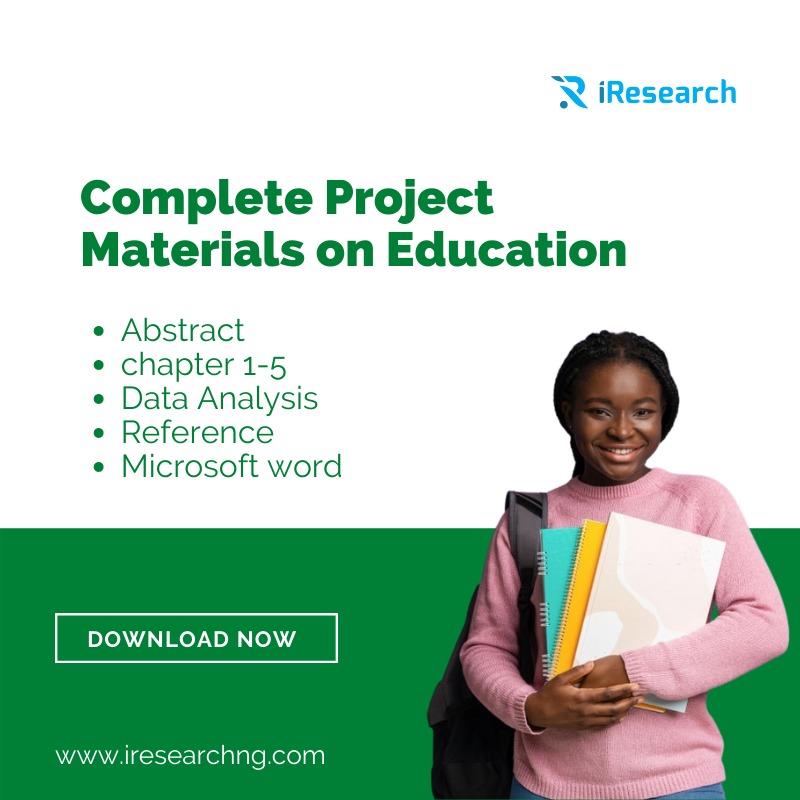



PARENTS' AND TEACHERS' ATTITUDES TOWARDS CHILDREN WITH LEARNING DISABILITIES IN SOME SELECTED SCHOOLS
CHAPTER ONE
INTRODUCTION
1.1 BACKGROUND OF THE STUDY
The process of delivering education to children with learning difficulties is regarded as one of the most pressing issues confronting humanity (Mular, 2001). This arose from the unfavorable sentiments that existed towards communities in the 1950s and 1960s, asking for the separation of learners with special needs from their usual peers and the assignment of them to separate courses. Many empirical studies were undertaken to evaluate the success of the separation, and the worldwide community agreed that more than 10% of school-aged children in every community suffer from at least one impairment (Rocklin, 1994). Furthermore, special education estimates indicate disability rates in poor nations are as high as 15%. (Conrin, 1994). Special education refers to a variety of educational options available to students with particular needs, based on the learner's level of difficulty and the importance of the special classes. Nayak (2008) investigated parents' and teachers' attitudes toward children with learning difficulties and discovered that instructors are excited to educate these children and are prepared to tackle the obstacles. It also indicates that parents communicate their concerns, which aids in the implementation of appropriate methods to reintegrate their children into society. Learning disability is a categorization that encompasses a variety of areas of functioning in which a person has trouble learning in a regular manner due to an unknown condition or circumstances. While the terms learning impairment and learning disorder are sometimes used interchangeably, they are not synonymous (Lewasdoski, 2007). Significant learning impairments in an academic field are referred to as learning disabilities. These issues, however, are insufficient to support a formal diagnosis. Learning disorder, on the other hand, is an established clinical diagnostic in which a person fits certain criteria set by a specialist (psychologist, predicatrician, etc). The distinction between the two lies in the severity, frequency, and intensity of reported symptoms and issues, thus they should not be confounded. When the phrase "learning disabilities" is used, it refers to a collection of conditions marked by a lack of development of certain academic language and communication skills (Fred, 2005). Although the exact origins of learning difficulties are unknown, many illnesses are thought to be linked to central nervous system malfunction, heredity, diet, and prenatal and early childhood damage (Jude, 2002). Despite the fact that all learning disorders are unique, kids with learning disabilities report several similar issues, such as sluggish and inefficient reading, slow essay writing, difficulty with organization and mechanics of writing, and frequent arithmetic calculation errors.
1.2 STATEMENT OF THE PROBLEM
Parental and educational attitudes toward children with learning difficulties are a difficulty in any community, but especially in Nigeria. There have been several debates, seminars, and conferences convened to address this subject, yet the problem remains unsolved. Rather, it appears to be getting worse every day, especially among elementary and secondary school instructors. The purpose of this study is to look into the attitudes of parents and instructors regarding children with learning difficulties in a few Ogun State schools.
1.3 OBJECTIVES OF THE STUDY
The study's goal is to look at the many types of learning difficulties that schoolchildren face. To educate parents and teachers on how to assess, identify, and educate learning challenged children. Also, to reduce isolation or prejudice among other children, as well as unfavorable stereotypes about children with special needs.
1.4 RESEARCH QUESTIONS
i. What are the types of learning difficulties that schoolchildren face?
ii.How can Parents and teachers be educated on how to assess, identify, and educate learning challenged children?
iii. How can isolation or prejudice among other children, as well as unfavorable stereotypes about children with special needs be reduced?
1.5 SIGNIFICANCE OF THE STUDY
The purpose of this study is to analyze parents' and teachers' attitudes toward children with learning difficulties in a few special schools in Ogun State.
i. It will draw parents' attention to their attitudes toward their children who have learning impairments.
ii. It will draw instructors' attention to their attitudes toward students with learning impairments.
iii. It will bring government attitudes toward children with learning difficulties to light.
iv. To determine the educational level of children with learning difficulties.
1.6 SCOPE OF THE STUDY
The focus of this research will be on the factors that influence parents' and instructors' attitudes toward children with learning difficulties. It will place a strong focus on the need for additional teacher training and support in Nigeria.
1.7 DEFINITION OF TERMS
Disability:Ailment, injury, or condition that makes it difficult for someone to do things that other people can do.
Learning is the process of gaining information. Studying has given me knowledge.
Attitude is a person's reaction to something, whether favorable or bad. The way you consider someone. Confident, often aggressive behavior that demonstrates you are unconcerned about other people's opinions and prefer to do things your own way.
Parent: A person's father or mother.
Teacher is a person who works as a teacher, usually at a school.
IMPACT: Having a significant impact.
Find Other related topics on:
NOT THE TOPIC YOU ARE LOOKING FOR?
Once payment is made, kindly send us your project topic, email address and payment name to +234 810 144 4147
Once payment is confirmed, Project materials will be sent to your email